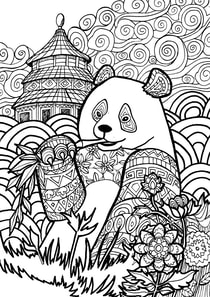This week's drawings
Materials:
- pencil
- eraser
- paper (printer paper, notebook, etc)
- colors (colored pencils, crayons, watercolor, etc)
- alternatives to the above: smart phone or tablet drawing app
Day 52: create a cartoon character
Day 53: a tower in two-point perspective
If you've done the previous perspective drawings, you know that the first step is to draw the horizon. For the tower, we'll draw our horizon in the middle of the page. Next, we draw our two vanishing points. Mark Kistler's step-by-step guide begins on page 185 of you can draw in 30 days. He proceeds to draw a box and then draws another box on the top and a third box at the bottom. He shows us how drawing the shadow using one of the vanishing points serves to anchor the tower to the ground.
He reviews our tower drawing using what he calls the Nine Fundamental Laws of Drawing (concepts that help us create our visual illusions):- Foreshortening (HINT: If you look at a cube and notice that one vertical edge is shorter than another vertical edge, what does that tell you?)
- Placement (HINT: If an object is closer to you than another object where is it placed vertically on your drawing?)
- Size (HINT: What happens to an object if you move it away from you?)
- Overlap (HINT: What is a way that you can tell if one object is nearer to you than another object?)
- Shading (HINT: What does shading do?)
- Shadow (HINT: What does a shadow do?)
- Contour (HINT: The contour defines the shape of an object. Cross-contour lines help to create form.)
-
Horizon (HINT: How is your drawing affected if there is no horizon?)
- Density (HINT: How do far away things appear different from near things?)
How do each of these work? How many do you know before you read Mark's review.
Ravi Jaiswar (a.k.a. #arttrap) demonstrates How to draw a building in two point perspective: Day 24 in his 16 minute video.
Here is my 1 minute video of my armadillo building:
- Foreshortening (HINT: If you look at a cube and notice that one vertical edge is shorter than another vertical edge, what does that tell you?)
- Placement (HINT: If an object is closer to you than another object where is it placed vertically on your drawing?)
- Size (HINT: What happens to an object if you move it away from you?)
- Overlap (HINT: What is a way that you can tell if one object is nearer to you than another object?)
- Shading (HINT: What does shading do?)
- Shadow (HINT: What does a shadow do?)
- Contour (HINT: The contour defines the shape of an object. Cross-contour lines help to create form.)
- Horizon (HINT: How is your drawing affected if there is no horizon?)
- Density (HINT: How do far away things appear different from near things?)
Day 54: the human nose
- How to Draw a Nose - Anatomy and Structure (7 minutes, 1.2M views)
- How to Draw a Nose - Step by Step (6 minutes, 2.6M views).
- Tell them what you’re going to tell them (he organizes this into 3 pieces
- simple nose box
- anatomy of nose
- advanced rendering of nose: break major -lanes into minor planes
- Tell them:
- simple nose box has two side planes, a top plane, and a bottom
- the anatomy of the nose is made up of 3 parts:
- bridge made of bone and cartilage;
- ball made of cartilage; and
- wings made of fatty tissue
- minor planes broken into 3 parts for three-quarter view:
- bridge has 2 top, 2 ridge and 2 side minor planes
- ball has top, front, bottom, and 2 side minor planes
- wings has top, 2 side, and bottom minor planes
- Show examples
Day 55: lettering in two-point perspective
Day 56: the foot
Day 57: color: color wheel
- PRIMARY
- SECONDARY
- TERTIARY
- Red
- Red-Orange
- Orange
- Yellow-Orange
- Yellow
- Yellow-Green
- Green
- Blue Green
- Blue
- Blue-Violet
- Violet
- Red-Violet
- Red
- Draw a circle.
- Draw a vertical line down the center of the circle
- Draw a horizontal across the center of the circle.
- Divide each segment (quarter circle) into 3 equal parts
- You now have 12 segments. Color each segment with a different color as listed above: Red, Red-Orange, Orange, Yellow-Orange, Yellow, etc.
Day 58: texture: invented vs simulated
- draw an animal partly or wholly covered with invented texture.
- draw simulated texture on an animal.





































